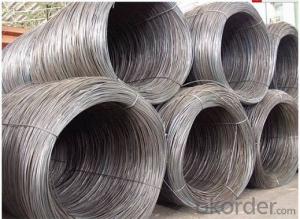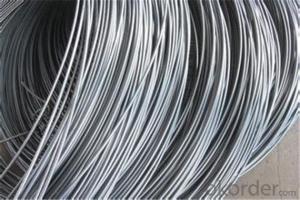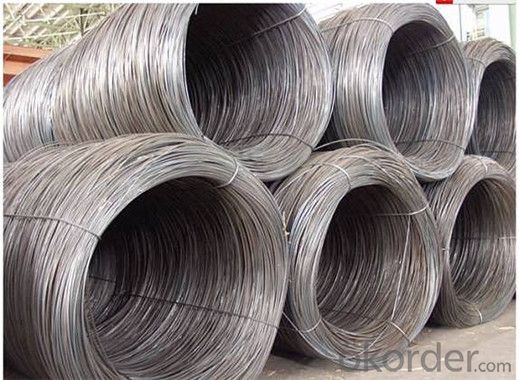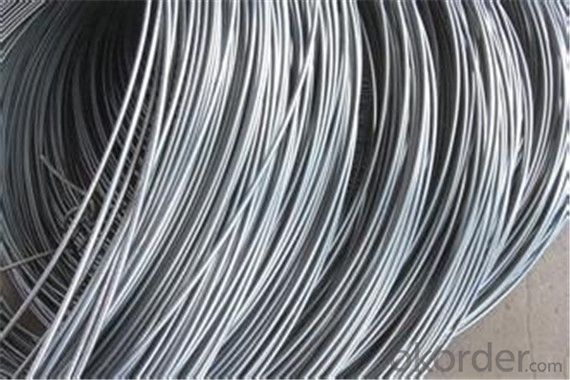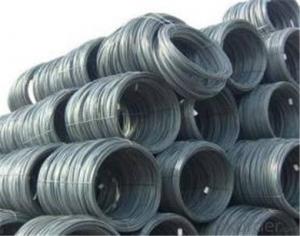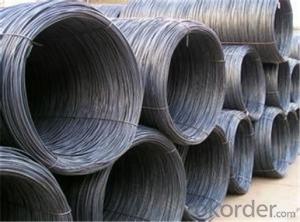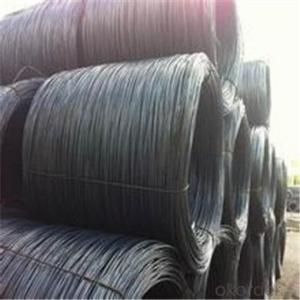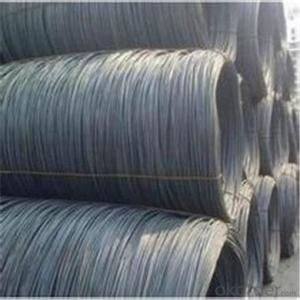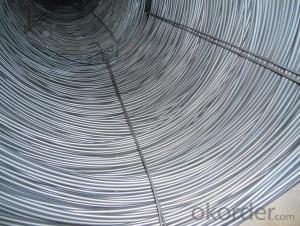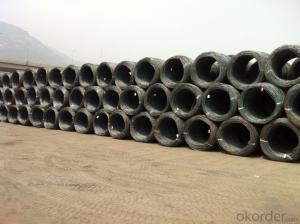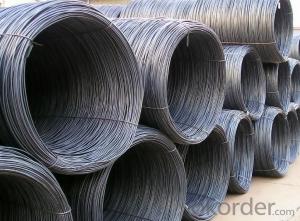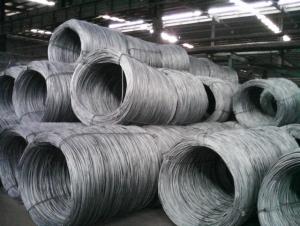SAE1006B Steel Wire Rod 6.5mm with in China
- Loading Port:
- Tianjin
- Payment Terms:
- TT OR LC
- Min Order Qty:
- 500 m.t.
- Supply Capability:
- 45555555 m.t./month
OKorder Service Pledge
OKorder Financial Service
You Might Also Like
Specification
Description of wire Rod:
Our company is recognized by ISO9001:2008
1. hot rolled wire rod
2. material: Q195-235
3. payment: T/T or L/C
4.size: 5mm-19mm
Festures of wire Rod:
1. Drawn wire specialist, your wire rod solution
2. ISO9001 Certified Mill &SGS
3. Feature: machinability, high hardness, toughness, corrosion resistant
4. Clear and smooth surface, high precision and Tolerance control: ± 0.01
Specifications of wire Rod:
Product | steel wire rod |
Standard | AISI, ASTM, BS, DIN, GB, JIS |
Material/steel grade | Q195-Q235,SAE1006, SAE1008, SAE1010, SAE1018, SAE1020 or according to customers requirements |
Wire Gauge | 5.5-12mm |
Coil weight | 1.8-2.1mts |
MOQ | 25MT |
Delivery Time | 15-30 days after receipt of L/C or deposit by T/T |
Packing | In coil and load in container, if large quantity, by bulk vessel; Can be packed as customers' special requirements |
Payment terms | 1).100% irrevocable L/C at sight. |
Application | widely used in machinery parts, manufacturing industry, electronics industry, metal tools and others |
Images of wire Rod:
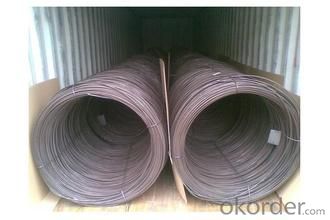
FAQ:
1. What is your package?
Packing situation: standard seaworthy packing or as customer required.
2. How long is the lead time?
Delivery time: 45 days after order confirmed.
3. What payment term do you accept?
Payment: T/T or L/C at sight.
- Q: How is steel wire rod tested for chemical composition?
- Steel wire rod is tested for chemical composition through a process called spectroscopy. This involves using a spectrometer to analyze the wavelengths of light emitted or absorbed by the sample. By comparing these wavelengths to known standards, the composition of the steel wire rod, including the percentage of various elements like carbon, manganese, and silicon, can be determined accurately.
- Q: What are the main factors affecting the product differentiation of steel wire rod?
- The main factors affecting the product differentiation of steel wire rod include the chemical composition, physical properties, size and shape, surface finish, and production process. These factors determine the specific characteristics and performance of the steel wire rod, allowing it to cater to various applications and meet specific customer requirements. Additionally, market demand, competition, and technological advancements also play a significant role in influencing the product differentiation of steel wire rod.
- Q: How is steel wire rod classified based on its carbon content?
- Steel wire rod can be classified based on its carbon content into three main categories: low carbon wire rod, medium carbon wire rod, and high carbon wire rod. Low carbon wire rod typically contains carbon levels ranging from 0.05% to 0.15%. It is characterized by its high ductility and excellent formability. This type of wire rod is commonly used in applications that require flexibility and bending, such as in the manufacturing of wires for fencing, nails, and construction materials. Medium carbon wire rod contains carbon levels ranging from 0.15% to 0.45%. It possesses higher strength and hardness compared to low carbon wire rod. Medium carbon wire rod is often used in applications that require both strength and flexibility, such as in the production of automotive parts, springs, and certain types of fasteners. High carbon wire rod has carbon levels ranging from 0.45% to 0.85%. It is known for its exceptional strength and hardness. High carbon wire rod is typically used in applications that require maximum strength, such as in the production of high-tensile wires used for suspension bridges, pre-stressed concrete structures, and wire ropes used in heavy machinery. The classification of steel wire rod based on carbon content allows manufacturers and consumers to choose the appropriate grade of wire rod for their specific needs, considering factors such as strength, flexibility, and durability requirements.
- Q: How are steel wire rods used in the production of bicycle spokes?
- Steel wire rods are an essential component in the production of bicycle spokes. These rods are typically made from high-quality steel, ensuring strength and durability. The manufacturing process begins with the wire rods being fed into a machine that straightens and cuts them to the required length for spokes. Once the wire rods are cut, they are further processed to create the desired shape. This is typically done by passing the rods through a machine that forms them into a "J-bend" shape, which is necessary for attaching the spokes to the bicycle hub and rim. After the rods are shaped, they are often subjected to a heat treatment process to enhance their strength and resilience. This process, known as annealing, involves heating the rods to a specific temperature and then slowly cooling them. Annealing helps to remove any internal stresses and improve the overall mechanical properties of the spokes. Next, the spokes are typically galvanized or coated with a protective layer to prevent corrosion. This coating not only enhances the appearance of the spokes but also increases their lifespan by providing resistance against rust and other forms of deterioration. Finally, the spokes are ready to be assembled into the bicycle wheel. They are inserted into the hub and threaded through the rim, forming a pattern that ensures optimal strength and stability. The spokes are then tightened to the appropriate tension, ensuring the wheel is properly aligned and balanced. In summary, steel wire rods play a crucial role in the production of bicycle spokes. They are used to create the necessary shape and strength, undergo heat treatment processes, and are coated to enhance their durability. Ultimately, the quality of the wire rods used greatly influences the performance and longevity of bicycle spokes.
- Q: What are the main applications of steel wire rod?
- The main applications of steel wire rod include manufacturing various types of wire products such as nails, screws, springs, cables, wires for electrical purposes, wire mesh for construction, reinforcement in concrete structures, and in the production of automotive parts.
- Q: What are the common applications of bright steel wire rod?
- Bright steel wire rods are commonly used in a variety of applications such as manufacturing nails, screws, wire mesh, springs, and other small metal components. They are also utilized in the construction industry for reinforcing concrete structures and in the automotive industry for making parts like cables and springs. Additionally, bright steel wire rods find application in the production of electrical wires, fencing, and various other industrial and household products.
- Q: What are the different surface marking methods for steel wire rod?
- Steel wire rods can be marked using various surface marking methods, each serving the purpose of identifying and providing information about the wire rod. One commonly used method involves hot stamping, which impresses an identification mark onto the surface of the wire rod using a heated stamp. This method is reliable and long-lasting since the mark becomes permanently engraved on the steel's surface. Another technique, inkjet printing, involves using an inkjet printer to directly print the necessary information onto the steel wire rod. This method is speedy and allows for flexibility in marking different types of information. Laser marking is also a popular choice, where a laser beam is utilized to remove or alter the surface material of the wire rod, leaving a permanent mark. This method offers precise and detailed markings. Moreover, embossing or engraving can be utilized to create raised or indented markings on the wire rod's surface. These methods are often employed for branding or decorative purposes, but can also convey important information about the wire rod. Ultimately, the selection of a surface marking method for steel wire rods depends on the manufacturer's specific requirements and preferences. Each method has its own advantages and limitations, necessitating careful consideration to ensure accurate and durable markings on the wire rods.
- Q: What are the different types of steel wire rod surface coatings?
- Some of the different types of steel wire rod surface coatings include galvanized coatings, zinc-aluminum coatings, and epoxy coatings.
- Q: How is steel wire rod used in the manufacturing of wire panels?
- Steel wire rod is an essential component in the manufacturing of wire panels. Wire panels are widely used in various industries, such as construction, agriculture, and fencing. The steel wire rod is initially processed through a series of steps to transform it into wire panels. Firstly, the steel wire rod is drawn through a wire drawing machine, which reduces its diameter to the desired size. This process involves pulling the wire rod through a series of dies, gradually decreasing its thickness and increasing its length. The drawn wire is then cut into specific lengths, depending on the dimensions required for the wire panels. Next, the cut wire is fed into a welding machine, where it is welded together to form a mesh-like structure. The welding process ensures that the wire panels have high tensile strength and structural integrity. There are various types of welding techniques used, such as resistance welding, spot welding, or fusion welding, depending on the specific requirements of the wire panels. After welding, the wire panels undergo a surface treatment process, typically galvanizing. Galvanizing involves coating the wire panels with a layer of zinc to protect them from corrosion and rust. This additional layer of protection ensures the longevity and durability of the wire panels, making them suitable for outdoor applications. Once the wire panels are galvanized, they are further processed to achieve the desired shape and size. This can involve cutting, bending, or molding the wire panels into specific configurations, depending on their intended use. For example, wire panels used in fencing may be bent to create a zigzag or diamond pattern, while those used in construction may be cut into rectangular shapes for reinforcement purposes. Overall, steel wire rod plays a crucial role in the manufacturing of wire panels. Its high tensile strength, flexibility, and resistance to corrosion make it an ideal material for creating durable and versatile wire panels used in various industries.
- Q: How does the price of steel wire rod fluctuate in the market?
- The market for steel wire rod experiences price fluctuations due to various factors. One significant factor is the dynamic between supply and demand within the steel industry. When there is a strong demand for steel wire rod, such as during periods of economic growth or construction booms, the price tends to rise. Conversely, when there is a decrease in demand or an oversupply of steel wire rod, the price tends to drop. Another factor that impacts the price of steel wire rod is the cost of raw materials. Typically, steel wire rod is produced from iron ore, which is subject to price changes in the global market. If the cost of iron ore increases, it can lead to higher production costs for steel manufacturers, resulting in higher prices for steel wire rod. In addition, fluctuations in energy prices can influence the price of steel wire rod. Steel production requires a significant amount of energy, particularly in the form of electricity and natural gas. If energy prices rise, it can increase production costs and ultimately lead to higher prices for steel wire rod. Moreover, changes in trade policies and tariffs can also have an impact on the price of steel wire rod. Governments may impose tariffs or trade restrictions on steel imports, which can limit the supply of steel wire rod in the market and potentially raise prices. Lastly, market speculation and investor sentiment can also contribute to price fluctuations in the steel wire rod market. Investors and traders may anticipate future changes in supply and demand or react to economic indicators, resulting in volatile price movements. In summary, the price of steel wire rod is influenced by a range of factors, including supply and demand dynamics, raw material costs, energy prices, trade policies, and market speculation. These factors can cause the price to fluctuate in response to changes in the broader economy and industry conditions.
Send your message to us
SAE1006B Steel Wire Rod 6.5mm with in China
- Loading Port:
- Tianjin
- Payment Terms:
- TT OR LC
- Min Order Qty:
- 500 m.t.
- Supply Capability:
- 45555555 m.t./month
OKorder Service Pledge
OKorder Financial Service
Similar products
Hot products
Hot Searches
Related keywords
